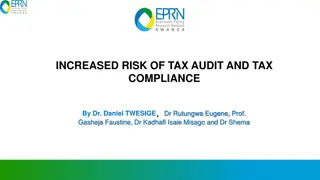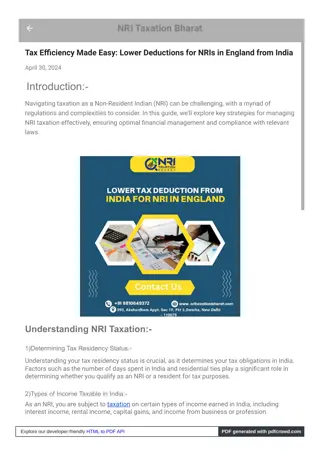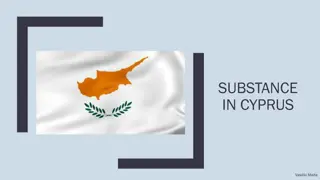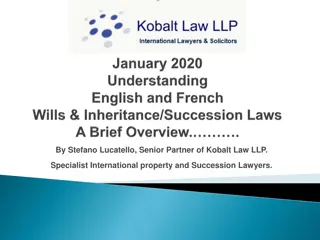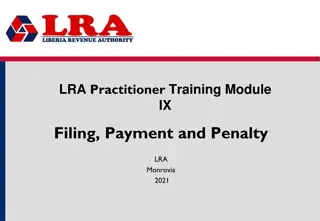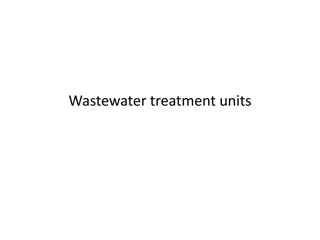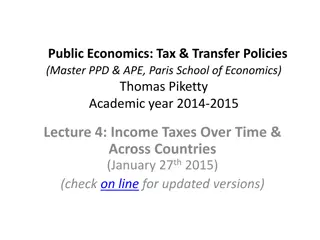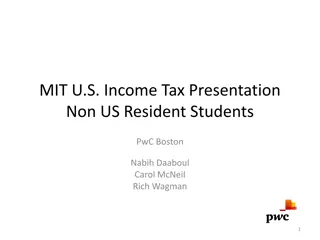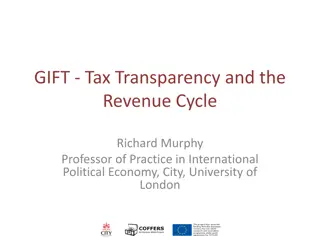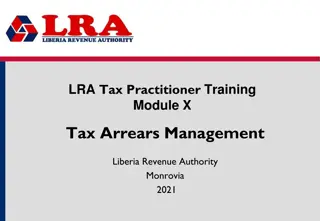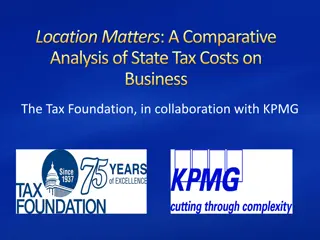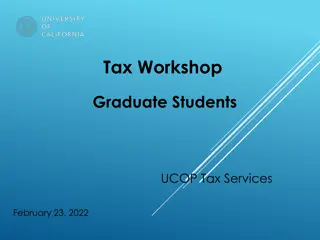
$1.6m Pension Cap Rules: Super & Estate Planning Strategies
Learn about estate planning strategies under the new $1.6 million pension cap rules to protect assets, minimize tax, and transfer wealth effectively to your family and dependents. Explore tax planning opportunities and superannuation smart planning to secure your financial future.
Download Presentation

Please find below an Image/Link to download the presentation.
The content on the website is provided AS IS for your information and personal use only. It may not be sold, licensed, or shared on other websites without obtaining consent from the author. If you encounter any issues during the download, it is possible that the publisher has removed the file from their server.
You are allowed to download the files provided on this website for personal or commercial use, subject to the condition that they are used lawfully. All files are the property of their respective owners.
The content on the website is provided AS IS for your information and personal use only. It may not be sold, licensed, or shared on other websites without obtaining consent from the author.
E N D
Presentation Transcript
Super & Estate Planning Strategies under the New $1.6m Pension Cap Rules IPA DISCUSSION GROUP SYDNEY BEN SYMONS BARRISTER STATE CHAMBERS
Overview of Estate Planning Purpose: (1) Protect assets in the event of bankruptcy, marital breakdown, or professional negligence; (2) Minimise tax; and (3) Cost effective transfer of wealth to family / dependents on death. Why relevant? Most people will typically have at least 3 major assets that require protection and planning: (i) A property; (ii) Superannuation; and (iii) Assets held in a family trust.
Plan early, review plan regularly Plan ahead before a situation arises where you need asset protection Review asset protection plan regularly: (i) assets change; (ii) beneficiaries may change, their circumstances may change; (iii) both impact on the most tax effective way to distribute assets. Ensure assets can be passed to down to future generations in accordance with your wishes
Tax planning opportunities in the event of death Make the most of the CGT death exemption: Assets passing to executor / beneficiary generally exempt from CGT; (i) BUT, assets passing to non-residents, tax-exempt bodies and superannuation funds do not have access to this concession. Avoid gifts to these entities; (ii) Smart use of Primary Residence Exemption by beneficiaries Testamentary Trusts - split income between minor beneficiaries at preferential tax rates Superannuation smart planning Life insurance CGT exemption for payment to policy holder, spouse or family member (child, parent, grandparent, aunt, uncle, niece, nephew, brother or sister). Exemption will not apply for joint policies between unrelated parties.
Superannuation tax in a fund Income derived by super fund taxable at 15%; Long term capital gains received by a super fund are taxed at 10%; Concessional contributions made to fund are taxed in the fund at 15%; Generally non-concessional contributions (e.g. contributions made on behalf of a spouse, rollovers from foreign funds) are not taxed in the fund Excess non-concessional contributions: (2014/2015): Individual taxpayers are liable to pay tax at 49% for non-concessional contributions that exceed $180,000 (effective tax rate capped at 95% for top marginal rate taxpayers) Excess non-concessional contributions can be withdrawn by making an election, but the associate income amount (essentially earnings of NCC) will remain taxable; 0% tax on earnings of fund when in pension phase
Taxation on payment of a super death benefit Generally payments (lump sum or pension) made to members over the age of 60 are tax free (see table below) Lump sum payments to a death benefit dependent or a person who is terminally ill are also tax free Non-dependents can only receive a lump-sum taxable per table below Non-dependents - from 1 July 2007 they cannot receive a pension pensions before this date are taxable at dependent tax rates
Who is a death benefit dependent Death benefit dependent (sec 302-195 ITAA 1997): Spouse or former spouse Child under 18 (i) (ii) (iii) Person who deceased had an interdependency relationship (iv) Person dependent at common law An interdependent relationship exists where two persons (sec 302-200 ITAA 1997): Have a close personal relationship; and Live together (unless either or both suffering from a disability); and (i) (ii) (iii) One or each provides the other with financial support or personal care.
Taxation on payment of a super death benefit Death benefit recipient Lump sum Pension tax rates (slide below) Yes Spouse (include de facto and same sex, but not a former spouse) Child under 18 Child 18+ and independent 18-25 & financially dependent 25+ & financially dependent Any age & interdependent relationship Any age & serious disability Yes Tax free Yes Tax free Yes Taxed Yes Tax free Yes Tax free Yes Tax free Yes Taxed Yes No Yes Yes Yes Yes
Taxation on payment of a super death benefit lump sum where taxed and pensions Age of beneficiary / deceased Part of taxable component Effective tax rate Beneficiary or deceased is greater than 60 years old Taxed element 0% Untaxed element Marginal tax rate less 10% tax offset Beneficiary and deceased are less than 60 years old Taxed element Marginal tax rate less 15% tax offset Untaxed element Marginal tax rate
Taxation of lump sum death benefit super payments to non-dependents Age of beneficiary / deceased Non-dependent receipt of lump sum Part of taxable component Taxed element Effective tax rate Marginal tax rate or 15%, whichever is lower, plus Medicare levy Marginal tax rate of 30%, whichever is lower, plus Medicare levy Untaxed element A pension cannot be paid to a non-death benefit dependent
General principles payment of a death benefit Superannuation does not automatically form part of your estate on death. The assets of a super fund fall to be administered by the trustee: According to the trust deed; (i) As modified by the SIS Act / regulations (ii) (The trustee is not bound to follow a direction in a will; Ioppolo -v- Conti [2015] WASCA 45) A death benefit must be cashed (pension or lump sum) immediately upon members death (SIS reg 6.21) A death benefit must be paid to: A dependent; (i) The deceased legal personal representative / executor; (ii) If neither of the above can be found, such person as the trustee nominates (SIS reg 6.22) (iii)
Death benefit nominations Must make a death benefit nomination to direct the trustee you would like your superannuation distributed. There are 3 types of nomination: Non-binding nomination (i) Binding death benefit nomination must renew every 3 years (ii) (iii) Non-lapsing binding death benefit nomination (independent or built in to trust deed) Some authority that non-lapsing binding death benefit nominations are valid for SMSF s (Munro v Munro [2015] QSC 61) May have multiple nominations (e.g. Pay mutiple pensions or lump sums) May have cascading nominations (e.g. If a beneficiary predeceases taxpayer, then the taxpayer has a secondary nominee)
Take care to make a valid nomination The case law is clear that binding death benefit nominations must be clear and precise, or else they will be invalid; Any nomination must be in accordance with trust deed Care should be taken to comply with trust deed and completing nomination form the use of word trustee of the deceased estate rather than the executor invalidated a binding death benefit nomination in Munro v Munro [2015] QSC 61 An invalid nomination is likely to have serious implications for the drafter, they are likely to be liable for a professional negligence (drafter likely to owe a duty of care to deceased as well as beneficiary contrast High Court case of Badenach v Calvert [2016] HCA 18)
Advantages / disadvantages of different nominations Type of nomination Non-binding nominations Advantages Flexibility for trustee decision making can take account of tax and non-tax considerations Disadvantages Deceased has no say in who super is distributed to Binding nominations renewable every 3 years (i) Super distributed according to deceased wishes (ii) Difficult to challenge if done properly (i) No flexibility for tax planning (ii) More administration must be renewed every 3 years Non-lapsing binding nomination (i) Super distributed according to deceased wishes (ii) Some authority that it is binding for an SMSF (see above) (iii) Less administration once off nomination (i) No flexibility for tax planning
Reversionary pension If deceased was in pension mode a nomination could be made to pay a reversionary pension to a death benefit dependent spouse, minor child or other dependent (lump sums only payable to non-dependents SIS reg 6.17A) Any nomination for a reversionary pension must accord with trust deed and terms of pension Advantages Preserve tax-free status of fund if in pension mode Less likely to be challenged that where no nomination ATO considers a reversionary pension prevails over a BDBN where trust deed silent Disadvantages Can t make nomination during accumulation phase Lacks flexibility for tax planning
Duties of an SMSF trustee in cashing a death benefit The trustee must exercise their discretion in accordance with the trust deed, the SIS regs and the principles of equity; From general principles in equity the trustee has the following duties: (i) to act in the best interests of the beneficiaries; (ii) to act in good faith; (iii) to avoid conflict of interest; (iv) to act impartially between different classes of beneficiaries In NSW, the trustee should also give thought to whether a family provision claim might be made on the estate (superannuation will almost always form part of the notional estate if the trustee pays out super being aware of an FPA claim and the super is dissipated, the trustee may be liable to a successful claimant) Forum to litigate a superannuation dispute: SMSF s disputes go to the Supreme Court Retail super funds disputes go to the Superannuation Tribunal (i) (ii)
Cases duties of a trustee in cashing a death benefit Wooster v Morris [2013] VSC 594 the deceased had around $1 million in his SMSF and made binding death benefit nominations in favour of his 2 adult daughters from his first marriage; His second wife was the surviving member and a director of the trustee company of the SMSF and resolved that the BDBN s were invalid, and paid the superannuation to herself as a dependent; His daughters sought a declaration that the BDBN was binding a valid on the trustee and that they were entitled to be paid the deceased super interest; Held: The Court found that the BDBN was valid (although it did not examine in detail why) and the second wife was orders to pay over the super money in dispute The second wife as director of the trustee, rather than the trustee company, was made personally liable for the costs of the plaintiffs The trustee director (second wife) had a conflict of interest with the other beneficiaries are she should have sought judicial advice
Cases - duties of a trustee in cashing a death benefit Ioppolo & Hesford v Conti [2015] WASCA 45 surviving trustee and member (second husband) paid the SMSF benefits to himself, despite a contrary direction in the deceased wife s will that the super be paid to her 4 daughters from her 1stmarriage; Two previous BDBN had been made in favour of her husband, both had lapsed after 2 years (not in force at time of her death) Held: the second husband / trustee did not exercise his powers with a lack of good faith there was no evidence to show that he didn t take account of the daughters interest or their financial position vis-a-vie his own financial position; However, the plaintiffs at first instance were refused an opportunity to cross examine because they had not given sufficient notice that they wanted to do so (the outcome may have been different is they had an opportunity to cross examine him); A trustee should judicial advice if they are facing a conflict of interest, are concerned that their bona fides may be questioned or are even unsure whether to honour a BDBN or pay a reversionary pension
Testamentary trusts tax advantages Now typically a standard clause in most wills a trust created by will upon death Tax advantage: can distribute income to resident minors (aged less than 18) at preferential marginal tax rates (excepted trust income within sec 102AG ITAA 1936) 0% tax on distributions up to $18,200 (i) Highest marginal tax rate of 47% (plus Medicare levy) only reached when distribution exceeds $180,000 + (ii) In comparison, distributions to minor beneficiaries from inter-vivos trusts taxed at penalty rates of 47% (plus Medicare levy)
Testamentary trusts payment of a super death benefit Either all the beneficiaries of the trust should be super death benefit dependents; or There should be a clause in the trust deed by which the superannuation assets are held specifically for death benefit dependents; Section 302-10 the trustee of the testamentary trust is personally liable for the tax in respect of pension payments to death benefit dependent beneficiaries; If the trustee is uncertain as to whether a death benefit dependent will benefit from the super assets under the testamentary trust withhold tax as if payment not made to a death benefit dependent
Testamentary trusts advantages / disadvantages Advantages Tax planning - Income can be distributed to minor beneficiaries are preferential tax rates Disadvantages Lack of long term flexibility beneficiaries determined by will. Cannot add a beneficiary without creating a new trust No access to main residence exemption for CGT or land tax On-going administrative costs Some flexibility the trustee can determine how distributions are made Asset protection creditors, vulnerable beneficiaries Streaming of capital gains and franking credits
Changes to superannuation 2016-2017 Federal Budget Treasury Laws Amendment (Fair and Sustainable Superannuation) Bill 2016 contains changes to superannuation laws enacted December 2016 to apply from 1 July 2017: (a) The EM stated that the purpose of superannuation is to provide for an individual s retirement; (b) Abolition of requirement that less than 10% of an individual s income must be earned from employment for superannuation contributions to be deductible to the individual; (c) The threshold at which the rebate cuts out for spousal contributions has been raised to $40,000 (from $13,800). A rebate of up to $540 may be granted. The rebate starts to decrease once a spouse earns more than $37,000 (previously $10,800); (d) Low income tax offset for individuals earning $37,000 or less. They are entitled to a rebate of up to $500 for concessional contributions. To continue indefinitely from 1 July 2017;
Changes to superannuation 2016-2017 Federal Budget (cont d) Further changes in the Act to commence 1 July 2017 (unless otherwise stated): (a) The annual non-concessional contributions cap will be reduced to $100,000 for individuals under 65 (from $180,000); (b) This will result in a 3 year bring-forward non-concessional contribution cap of $300,000; (c) Individual s with superannuation balances greater than $1.6 million will no longer be able to make non-concessional contributions; (d) The threshold at which Division 293 tax applies will be reduced to $250,000 from $300,000; (e) The concessional contributions cap will be reduced to $25,000 for all individuals (previously $30,000 for under 50 s and $35,000 for 50+); Individual's will be able to transfer a maximum of $1.6 million in to a tax-free retirement phase account; and (f) (g) Individuals with super balances of less than $500,000 are allowed to make catch up concessional contributions for their unused concessional caps for up to 5 years (commencing 1 July 2018).
Changes to superannuation 2016-2017 Federal Budget (cont d) Transfer balance cap of $1.6 million: (a) Only amounts transferred to retirement account are included; (b) Earnings on capital in retirement account not included; (c) The $1.6 million will be indexed to inflation Where the $1.6 million transfer balance cap is exceeded, the Commissioner can direct the super income stream to be commuted to bring the assets supporting the super income stream below the $1.6 million threshold; (a) Excess transfer balance earnings tax will apply to the notional earnings on the excess balance
Changes to superannuation 2016-2017 Federal Budget (cont d) A super income stream can be commuted to a super lump sum prior to 1 July 2017 and moved to an accumulation account: (a) Segregated funds - transfer out CGT free, to the extent transfer made to bring pension account under $1.6 million then asset cost bases are refreshed to market value at 1 July 2017 or before; (b) Unsegregated funds CGT arises and should be calculated based on the proportional method: (1) However, a fund may choose to defer a gain on these assets until the asset is sold; (2) The assets cost base can be refreshed at 1 July 2017 ; Such a choice must be made by approved form. Where a taxpayer is receiving a super income stream and becomes entitled to a reversionary super income stream, they have 12 months to rectify their transfer balance cap without penalty
Changes to superannuation 2016-2017 Federal Budget (cont d) Defined benefit income stream taxed element: (a) Half of income over $100,000 included in individual s taxable income and taxed at margin rates (previously 0%); Defined benefit income stream untaxed element; (a) The 10% tax offset is limited to the first $100,000 of income on the untaxed element. The excess is taxed at margin rates Super death benefit dependents generally retain their existing treatment: (a) But if they receive a defined benefit income stream, their defined benefit income cap is reduced accordingly.
Remember planning opportunities SMSF s still offer fantastic tax and wealth management planning opportunities; Make the most of opportunities to buy and develop property; Make the most of the small business CGT concessions in eliminating capital gains by making contributions to an SMSF (these contributions are not subject to the concessional or non-concessional contribution cap); Ensure that appropriate binding death benefit nominations are in place; Seek expert advice to ensure that these strategies are properly implemented
Transitional CGT relief SMSFs complying with the transfer balance cap From 1 July 2017, SMSF s are permitted to transfer a maximum of $1.6 million of assets to an account that supports a pension (the earnings on those assets being free from tax); In order to comply with the transfer balance cap of $1.6 million, assets must be commuted from pension phase to accumulation phase (or to a different fund); The government is offering CGT relief (a transfer tax free) and an opportunity to step the cost base of these assets up at the time that the reforms take effect; The following slides discuss planning issues in relation to segregated and non-segregated funds
Transitional CGT relief basic qualifying conditions Applies to funds existing at or before 9 November 2016; Must be a complying Australian superannuation fund; Asset must have been owned from 9 November 2016 or earlier; Election for transitional relief made on an asset by asset basis; Asset must be owned continuously from 9 November until cessation time (30 June 2017 at the latest)
Transitional CGT relief segregated funds Can de-segregate any time up until 30 June 2017 30 June 2017 Can transfer assets out of a segregated account / de-segregate any time up until 30 June 2017; Can elect CGT relief on an asset by asset basis: Disregard gain (asset sale from segregated fund in pension mode not taxable); and Reset cost base of asset at de-segregation time reset to market value; 2 main reasons not to choose CGT relief: Where a capital loss will be realised on the asset; Where the asset will be sold before 30 June 2018 and the 1/3rdcapital gains tax discount for trust can be utilised (asset held on capital account for greater than 12 months) Main reason to de-segregate prior to 30 June 2017 is that taxpayer may want access to the 1/3rdcapital gains tax discount earlier than 30 June 2018 (i) (ii) (i) (ii)
Example: de-facto segregated fund Bronte superannuation funds holds the following assets: Acq. date Asset Member Acq. Amount Acq. Price Cost base Current value Unrealised gain/(loss) CBA shares Peter Jul-09 15,000 $38.66 $579,900 $1,266,750 $686,850 Telstra shares Peter Jan-02 270,000 $5.58 $1,506,600 $1,239,300 -$198,000 CSL shares Penny Feb-08 10,000 $35.98 $359,800 $1,259,100 $899,300 Bronte property Penny Jan-12 $1,500,000 $1,500,000 $3,000,000 $1,500,000 Assume all assets supporting a pension from before 9 November 2016 until present; Transfer Bronte property to a separate accumulation fund (lump asset): Gain not taxable (sold out of a segregated fund in pension phase); (i) Cost base stepped up to $3,000,000; (ii) At current price, not sensible to make election in respect of Telstra shares if transferring them out there is an unrealised loss on this asset
Example: 2 funds post transfer 1 July 2017 Market value Market value Asset CBA shares CSL shares Member Gain/(loss) Asset Telstra shares Bronte property Penny Member Gain/(loss) Peter $1,266,750 $686,850 Peter $1,239,300 -$198,000 Penny $1,259,100 $899,300 Current value 755,460 $3,000,000 $1,000,000 Asset CSL shares Telstra shares 918,000 Segregated fund for each member Unsegregated accumulation fund for each member Telstra shares unrealised loss no election in relation to transitional CGT regime Cost base of Bronte property stepped up to $3,000,000 Gain assets in segregated fund, slower growth assets in unsegregated accumulation fund
Transitional CGT relief non- segregated funds 30 June 2017 Funds using the proportional method can elect that assets in excess of the $1.6 million transfer balance are eligible for CGT relief; Can elect CGT relief on an asset by asset basis: Defer gain ((market value cost base) x ECPI% (exempt current pension income %)); and Reset cost base of asset at de-segregation time reset to market value; 3 main reasons not to choose CGT relief: Where a capital loss will be realised on the asset; Trade off: where future ECPI % likely to be higher than present ECPI% (trade off against resetting cost base); Whether carry forward capital losses available to offset any capital gains realised now (and whether capital losses are likely to be available in the future); Where the asset will be sold before 30 June 2018 and the 1/3rd capital gains tax discount for trust can be utilised (asset held on capital account for greater than 12 months) (i) (ii) (i) (ii) (iii) (iv)
Example: de-facto segregated fund Bronte superannuation funds holds the following assets: Deferred gain Acq. date (50%) Asset Member Acq. Amount Acq. Price Cost base Current valueUnrealised gain/(loss) CBA shares Peter Jul-09 15,000 $38.66 $579,900 $1,266,750 $686,850 No election Telstra shares Peter Jan-02 270,000 $5.58 $1,506,600 $1,239,300 -$198,000 CSL shares Penny Feb-08 10,000 $35.98 $359,800 $1,259,100 $899,300 $373,001 Bronte property Penny Jan-12 $1,500,000 $1,500,000 $3,000,000 $1,500,000 50% of assets in both Peter and Penny s fund support their respective pensions from 9 November to present; No change necessary to bring Peter under $1.6 million threshold; Proportionate adjustment to Penny s assets results in a deferred gain on the part transfer necessary to bring her under $1.6 million, 50% of the income of the fund is exempt concessional pension income therefore 50% of the deferred gain taxable when the asset is sold; Take care: splitting these assets to settle a divorce / family law dispute (some assets may have greater tax liabilities than others)
Estate planning: death benefit planning example Peter and Penny (husband and wife) are members of the same SMSF and each have balances as below(assume entire balance compromised of tax element); Acq. Current value Unrealised gain/(loss) Asset Member Acq. date Amount Acq. Price Cost base CBA shares Peter Telstra shares Jul-09 15,000 $38.66 $579,900 $1,266,750 $686,850 Peter Jan-02 270,000 $5.58 $1,506,600 $1,239,300 -$198,000 CSL shares Penny Bronte property Feb-08 10,000 $35.98 $359,800 $1,259,100 $899,300 Penny Jan-12 $1,500,000 $1,500,000 $3,000,000 $1,500,000 They have 2 children one is 16 and one is 20 at the time of Penny s death; Penny passes away. What is the most tax effective way to transfer her SMSF balance?
Estate planning: death benefit planning example Super balance passes to Penny s Estate If super balances passed to her estate, risk that it is deemed to be income to which no beneficiary is presently entitled if the income would have been assessable income to the deceased if she were alive (if Penny was less than 60 when she passed away). The trustee could arguably be subject to tax at punitive rates (s101A ITAA 1936); In practice, the trustee will be subject to tax at the marginal rates of the deceased (with the tax-free threshold dropping to $416 in the fourth and subsequent income years of administration - https://www.ato.gov.au/individuals/deceased-estates/doing-trust-tax-returns- for-a-deceased-estate/tax-rates/); Death benefit dependent is ultimately taxable in the same way as if they had received the money directly (s 302-10 ITAA 1997)
Estate planning: death benefit planning example Super balance passes to adult children If super balance passes to deceased adult children who are on top marginal rate and entire balance consists of a taxed element, they will be subject to tax on lump sum death benefit at 17% ($4,259,100 * 17% = $724,047); If super balance passes to deceased adult children who are on top marginal rate and super balances consists of a 50% taxed element and 50% untaxed element, they will be subject to tax on lump sum death benefit at 15% ($4,259,100 * 0.5 * 17% + $4,259,100 * 0.5 * 32% = $1,043,480); Untaxed element may arise where: life insurance payout or payment from a State government super fund (constitutionally protected fund) Super balance transfer to Peter or a child under 18 at the time of payment: Lump sum: transfer to Peter as a death-benefit dependent (spouse) would be tax free; Alternatively, pay Peter a pension: Peter is not subject to tax on the taxed element
Estate planning super death benefits going forward Lump sum super death benefits will be contributed to family trusts; The non-concessional contribution rules that apply from 1 July 2017 will make it difficult to recontribute a large super lump sum death benefit to another super fund; The transfer balance cap rules will limit any death benefit super that can be kept in a fund and paid out as a pension; and The surplus money is likely to find its way in to family trusts.
Transitional CGT relief part IVA considerations See particularly paragraphs 42 50C of LCG 2016/8; Mere single asset transfer out of a segregated fund to comply with the new transfer balance cap of $1.6 million will not result in a tax benefit; Contrived schemes involving transfers of assets in to and out of a segregated fund likely to attract Part IVA (LCG 2016/8 paragraph 50B); Query whether the creation of two separate funds as follows would attract Part IVA: One fund is a segregated fund with assets less than $1.6 million; (i) Other funds is an unsegregated fund holding surplus assets. (ii)
Contact details Ben Symons Barrister-at-law State Chambers 52 Martin Place Sydney NSW 2000 Ph: 9223 1522 Email: bsymons@statechambers.net LinkedIn: https://au.linkedin.com/in/ben-symons-617b4b111



![Town of [Town Name] Real Estate Tax Rates and FY 2024 Budget Summary](/thumb/62211/town-of-town-name-real-estate-tax-rates-and-fy-2024-budget-summary.jpg)
